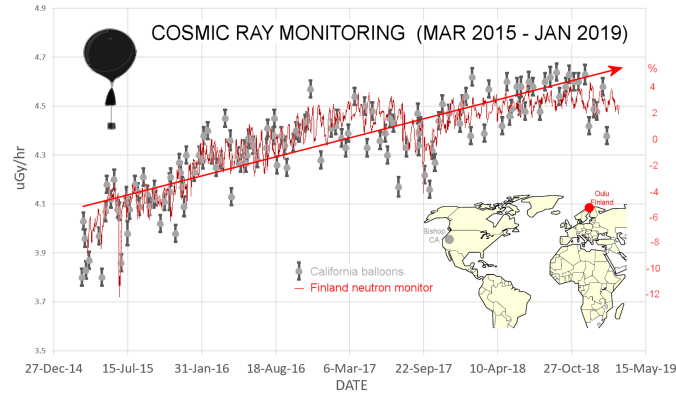See other Science/Tech Articles
Title: A Perfect Storm of Cosmic Rays
Source:
[None]
URL Source: https://tallbloke.wordpress.com/201 ... of-cosmic-rays/comment-page-1/
Published: Dec 29, 2019
Author: Dr Tony Phillips
Post Date: 2019-12-29 10:19:33 by Horse
Keywords: None
Views: 828
Comments: 5
April 23, 2019: Ten years ago, NASA reported a “perfect storm of cosmic rays.” During the year 2009, radiation peppering Earth from deep space reached a 50-year high, registering levels never before seen during the Space Age. It’s about to happen again. Ground-based neutron monitors and high-altitude cosmic ray balloons are registering a new increase in cosmic rays. The Oulu neutron monitor in Finland, which has been making measurements since 1964, reports levels in April 2019 only percentage points below the Space Age maximum of 2009: What’s going on? The answer is “Solar Minimum.” During the low phase of the 11-year solar cycle, the sun’s magnetic field and solar wind weaken. Cosmic rays find it easier to penetrate the inner solar system. In 2009, the sun experienced the deepest solar minimum in a century. Cosmic rays reaching Earth naturally surged. Ten years later, solar minimum is back with renewed weakening of the sun’s magnetic field and the solar wind. Again, it’s a “perfect storm.” A panel of experts led by NOAA and NASA recently predicted that the current minimum would reach a nadir in late 2019 or 2020, likely matching the record-setting minimum of 2009. If they’re right, cosmic rays will continue to increase, with a new record possible in the near future. Cosmic rays cause “air showers” of secondary particles when they hit Earth’s atmosphere. Indeed, this is what neutron monitors and cosmic ray balloons are measuring–the secondary spray of cosmic rays that rains down on Earth. This spray is of special interest to air travelers. Secondary cosmic rays penetrate the hulls of commercial aircraft, dosing passengers with the whole body equivalent of a dental X-ray even on ordinary mid-latitude flights across the USA. International travelers receive even greater doses. The International Commission on Radiological Protection has classified pilots as occupational radiation workers because of accumulated cosmic ray doses they receive while flying. Moreover, a recent study by researchers at the Harvard School of Public Health shows that flight attendants face an elevated risk of cancer compared to members of the general population. They listed cosmic rays as one of several risk factors. Poster Comment: We are setting records for the number of days without sunspots. That by definition means we are entering a solar minimum like the Maunder Minimum where more cosmic rays strike the earth thus energizing the ground beneath our feet for more earthquakes and volcanoes. The reduction in solar activity means fewer cosmic rays are blocked. Rough 30 tears ahead.


Post Comment Private Reply Ignore Thread
Top • Page Up • Full Thread • Page Down • Bottom/Latest
#1. To: Horse (#0)
I'm glad I do not fly. But I know a Russian babe who went back to Russia for her inheritance. She must be married to get it. So she is using me as her fiancé and telling them I am unable to travel. That is just fine. She told me she would teach me Russian when she gets back to the States. I also know a girl who is originally from Houston. Her family moved up to San Antonio to get out of that flood prone area. She is now in Ghana on business and will soon be coming back to the U.S. and into my arms. ;) "When bad men combine, the good must associate; else they will fall, one by one." Edmund Burke
A woman did a study of airline personnel who fly a lot. They are not doing well. Ditto for the planes.
The Truth of 911 Shall Set You Free From The Lie
I can imagine what the Cosmic rays do to the airframes. ;) "When bad men combine, the good must associate; else they will fall, one by one." Edmund Burke
Not the cosmic rays. All that radiation from Fukushima, Chernobyl and 1,200 open air H bomb blasts plus all the Depleted Uranium shells has produced something called the Wigner effect. It means that metal exposed to radiation is discomposed over time. It is the reason why nuclear power plants are supposed to be retired after 40 years. Lots of radiation in the upper atmosphere.
The Truth of 911 Shall Set You Free From The Lie
It is the reason why nuclear power plants are supposed to be retired after 40 years. Yes, the containment structure gets saturated with radiation. Thus the reactor must be retired after 40 years. Zion nuclear power plant in northern Illinois was opened in 1973 and has run its 40 year life cycle. The 2nd reactor at that site was opened in 1974 and it is also run its life cycle. ;) "When bad men combine, the good must associate; else they will fall, one by one." Edmund Burke
#2. To: BTP Holdings (#1)
#3. To: Horse (#2)
Ditto for the planes.
#4. To: BTP Holdings (#3)
#5. To: Horse (#4)
Wigner effect
Top • Page Up • Full Thread • Page Down • Bottom/Latest